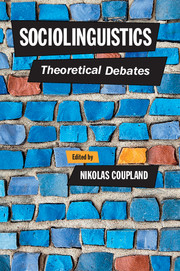Book contents
- Frontmatter
- Contents
- List of contributors
- Preface and acknowledgements
- 1 Introduction: Sociolinguistic theory and the practice of sociolinguistics
- Part I Theorising social meaning
- Part II Language, markets and materiality
- Part III Sociolinguistics, place and mobility
- 9 Mobile times, mobile terms: The trans-super-poly-metro movement
- 10 Sedentarism and nomadism in the sociolinguistics of dialect
- 11 From mobility to complexity in sociolinguistic theory and method
- Part IV Power, mediation and critical sociolinguistics
- Part V Sociolinguistics, contexts and impact
- Part VI The evolution of sociolinguistic theory
- Index
- References
10 - Sedentarism and nomadism in the sociolinguistics of dialect
from Part III - Sociolinguistics, place and mobility
Published online by Cambridge University Press: 05 June 2016
- Frontmatter
- Contents
- List of contributors
- Preface and acknowledgements
- 1 Introduction: Sociolinguistic theory and the practice of sociolinguistics
- Part I Theorising social meaning
- Part II Language, markets and materiality
- Part III Sociolinguistics, place and mobility
- 9 Mobile times, mobile terms: The trans-super-poly-metro movement
- 10 Sedentarism and nomadism in the sociolinguistics of dialect
- 11 From mobility to complexity in sociolinguistic theory and method
- Part IV Power, mediation and critical sociolinguistics
- Part V Sociolinguistics, contexts and impact
- Part VI The evolution of sociolinguistic theory
- Index
- References
Summary
Introduction
Perhaps one sign of a maturing discipline is a willingness on the part of its practitioners to introspect, self-critique and reflect upon what the field has taken for granted in its quest for progress. As Eckert (2003: 392) has argued, ‘we have to take a look at the givens and consider their implications for what we've done, and for what we will do in the future’. There comes a point, she says, when theoretical and methodological assumptions that have previously been swept under the carpet ‘have done their work and it is now time to pull them out and examine what they have helped us take for granted’ (2003: 396). One particular ‘elephant in the room’ that has come in for considerable unpacking in recent years is the concept of the ‘authentic speaker’ (in addition to Eckert 2003, see Bucholtz 2003; Coupland 2010), the ‘ideal’ informant with all of the ‘right’ social characteristics that suit the analysis to be conducted. In dialectological theory and practice, the ‘authentic speaker’ has been a particularly large elephant.
In this spirit, I turn the attention to another elephant and present an account of the ways in which differing stances towards mobility have permeated theory and practice in dialectology, from the early nineteenth-century studies through to the present. In assessing how ideologies of mobility have shaped dialectological practice, I draw heavily from contemporary debates in cultural geography that have explored ‘the way the geographical imagination … provides an underlying metaphysics that influences and informs thought and action’ (Cresswell 2006: 25). I begin, therefore, by outlining recent discussions about one particularly powerful underlying metaphysics that concerns ‘imaginations of mobility’, discussions which examine ‘the mobilization of mobility as a root metaphor for contemporary understandings of the world of culture and society’ (Cresswell 2006: 25–26). I highlight, first, the ongoing geographical critique of how mobility is imagined, conceptualised and ‘managed’ at two opposing poles – at one end ‘the propensity to see the world in fixed and bounded ways’, at the other ‘a way of seeing that takes movement as its starting point’ (Adey 2010: 40) – pointing to contemporary mobility theorists’ attempts to carve out a more nuanced middle path between the two, sensitive to the concerns of each.
- Type
- Chapter
- Information
- SociolinguisticsTheoretical Debates, pp. 217 - 241Publisher: Cambridge University PressPrint publication year: 2016
References
- 29
- Cited by



